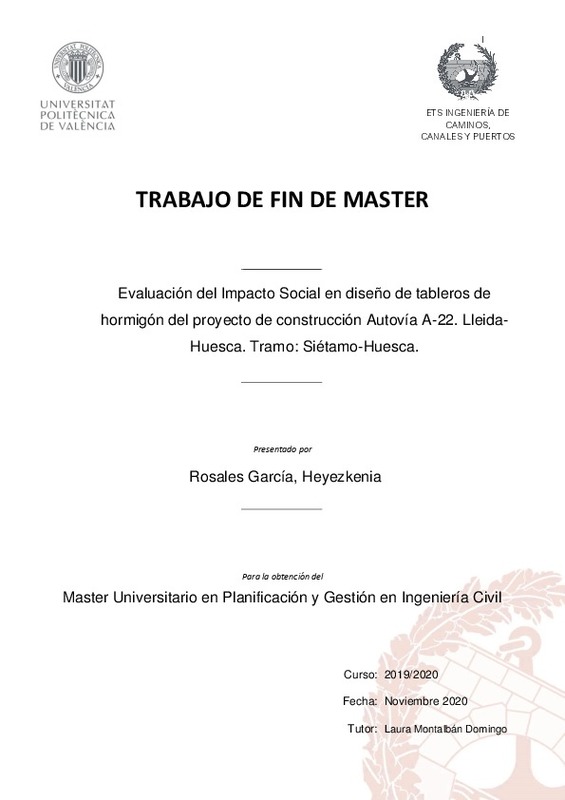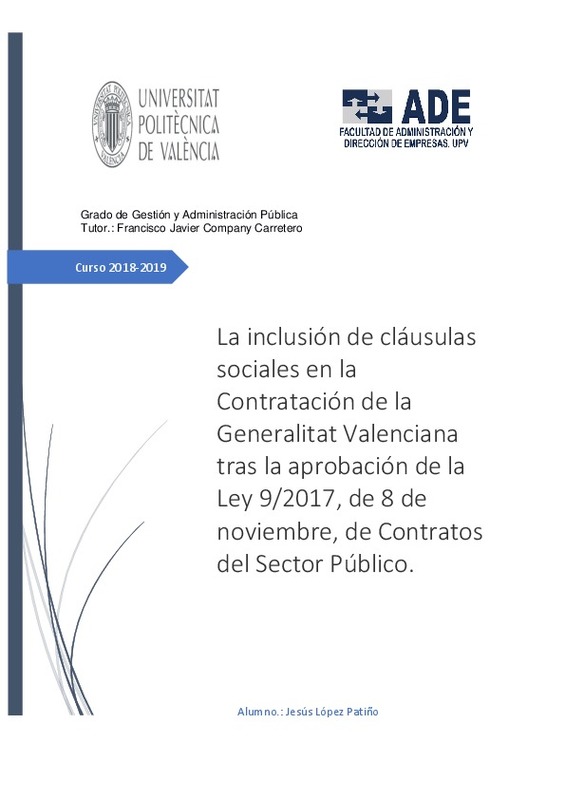JavaScript is disabled for your browser. Some features of this site may not work without it.
Buscar en RiuNet
Listar
Mi cuenta
Estadísticas
Ayuda RiuNet
Admin. UPV
Evaluación del impacto social en el diseño de tableros de hormigón del proyecto de construcción Autovía A-22. Lleida-Huesca. Tramo: Siétamo-Huesca.
Mostrar el registro sencillo del ítem
Ficheros en el ítem
| dc.contributor.advisor | Montalbán Domingo, María Laura
|
es_ES |
| dc.contributor.author | Rosales García, Heyezkenia
|
es_ES |
| dc.coverage.spatial | east=-0.30127069340528445; north=42.124337233292714; name=22120 Siétamo, Huesca, Espanya | es_ES |
| dc.date.accessioned | 2020-12-14T16:52:10Z | |
| dc.date.available | 2020-12-14T16:52:10Z | |
| dc.date.created | 2020-11-24 | |
| dc.date.issued | 2020-12-14 | es_ES |
| dc.identifier.uri | http://hdl.handle.net/10251/157175 | |
| dc.description.abstract | [ES] La Comisión Europea considera la sostenibilidad como uno de los objetivos prioritarios para los proyectos actuales y las inversiones futuras. Desde las instituciones académicas hasta las diferentes industrias, ha habido un aumento significativo en integrar y adoptar practicas sostenibles. La creciente conciencia para evaluar la sostenibilidad dado lugar al desarrollo de varias herramientas de evaluación del ciclo de vida ambiental (ELCA) y modelos de costos del ciclo de vida (LCC) que pueden evaluar cuantitativamente los impactos ambientales y económicos de un producto a lo largo ciclo vital. No obstante, la dimensión social del desarrollo sostenible parece se encuentra en una etapa temprana de desarrollo, especialmente cuando faltan métodos para evaluar el desempeño social. Es por ello que este trabajo pretende evaluar el impacto social en el diseño de las diferentes tipologías estructurales contempladas para los tableros del proyecto de construcción Autovía Lleida-Huesca (A-22). Tramo Siétamo-Huesca. Se realizará una comparación de las alternativas de tablero prefabricado frente a tableros ejecutados in situ. Para ello se aplicó metodología propuesta por Directrices para la Evaluación del Ciclo de Vida Social de los Productos propuesta por UNEP- SETAC (2009), y la metodología estandarizada ISO 14040 (2006) e ISO 14044 (2006); ambos marcos metodológicos se adaptaron a las particularidades del enfoque de evaluación del impacto social en obras civiles y las características específicas de este estudio. La adaptación metodológica contemplo por un lado la definición de indicadores de sostenibilidad social enfocados al sector de la construcción, y por otro el establecimiento de un método de normalización y caracterización basado en puntos de referencia de desempeño (PRP), relacionado el resultado obtenidos en los indicadores con el contexto en donde se desarrolla la actividad. Se analizaron dos alternativas de diseño para las 3 estructuras de pasos superiores y 2 estructuras de viaductos. La alternativa 1 se compone de elementos de tableros de Vigas Prefabricadas Pretensadas, losa auto portante y pilas prefabricadas; mientras que la alternativa 2 está compuesta de elementos fabricados totalmente in situ, en el caso de los pasos superiores y de elementos prefabricados en el caso de los viaductos. Cabe destacar que los valores obtenidos en los indicadores de este, se normalizaron y caracterizaron integrando la contribución de la actividad y las puntuaciones de desempeño, usando un sistema de ponderación igualitario. Los resultados obtenidos muestran que las alternativas relacionadas con elementos prefabricados tienen mejor desempeño social global en el contexto en donde se desarrolla la actividad, en comparación con la alternativa In Situ. Esto permite inferir que el tiempo de construcción según el sistema constructivo empleado afecta considerablemente el resultado del impacto social que genera cada alternativa. Sin embargo, la alternativa 2 tiene un mejor impacto social en la categoría de sociedad, la cual está directamente relacionada con el uso de recursos locales, esto motivado a que el uso la fabricación in situ permite generar gasto directo en el sitio donde se desarrolla el proyecto. En el caso de que ambas alternativas cuenten con las mismas características, los materiales empleados para construcción, el tiempo en ejecutar el proyecto y los costos derivados del empleo de estas se convierten en un factor determinante al momento de elegir entre alguna de estas alternativas. Se realizó dos análisis de sensibilidad; en el primer análisis se varió el sistema de ponderación, asignando diferentes pesos a las partes interesadas. En el segundo análisis de sensibilidad se estudió la importancia del contexto en el que se desarrolla la actividad; buscando evaluar la variación del desempeño social de las alternativas a través de diferentes contextos, y su alteración con respecto | es_ES |
| dc.description.abstract | [EN] The European Commission considers sustainability as one of the priority objectives for current projects and future investments. From academic institutions to different industries, there has been a significant increase in integrating and adopting sustainable practices. The increasing awareness to assess sustainability led to the development of various Environmental Life Cycle Assessment (ELCA) tools and Life Cycle Cost (LCC) models that can quantitatively assess the environmental and economic impacts of a product throughout life cycle. However, the social dimension of sustainable development appears to be in an early stage of development, especially when methods to assess social performance are lacking. That is why this work aims to evaluate the social impact in the design of the different structural typologies contemplated for the boards of the Lleida-Huesca (A-22) highway construction project. Siétamo-Huesca section. A comparison will be made of the precast board alternatives versus boards executed in situ. For this, the methodology proposed by the Guidelines for the Evaluation of the Social Life Cycle of Products proposed by UNEP- SETAC (2009) , and the standardized methodology ISO 14040 (2006) and ISO 14044 (2006) were applied; Both methodological frameworks were adapted to the particularities of the social impact assessment approach in civil works and the specific characteristics of this study. The methodological adaptation contemplated, on the one hand, the definition of social sustainability indicators focused on the construction sector, and on the other, the establishment of a standardization and characterization method based on performance benchmarks (PRP), related to the result obtained in the indicators with the context in which the activity takes place. Two design alternatives were analyzed for the 3 overpass structures and 2 viaduct structures. Alternative 1 is made up of elements of Precast Beams, self-supporting slab and precast piles; while alternative 2 is composed of elements manufactured entirely in situ, in the case of overpasses, and prefabricated elements in the case of viaducts. It should be noted that the values obtained in the indicators of this were normalized and characterized by integrating the contribution of the activity and the performance scores, using an equal weighting system. The results shown show that the alternatives related to precast elements have a better overall social performance in the context where the activity takes place, compared to the In Situ alternative. This allows us to infer that the construction time according to the construction system used considerably affects the result of the social impact generated by each alternative. However, alternative 2 has a better social impact in the category of society, which is directly related to the use of local resources, this motivated to the fact that the use of on-site manufacturing allows generating direct spending at the site where the project is developed. draft. In the event that both alternatives have the same characteristics, the materials used for construction, the time to execute the project and the costs derived from the use of these options will be a determining factor when choosing between any of these alternatives. Two sensitivity analyzes were performed; In the first analysis, the weighting system was varied, assigning different weights to the interested parties. This allowed us to confirm that alternative 1 performs more optimally from the social point of view, regardless of the weight assigned to the criteria. In the second sensitivity analysis, the importance of the context in which the activity takes place was studied; seeking to evaluate the variation of the social performance of the alternatives across different contexts, and its alteration with respect to the final score. In this, a moderately significant variation of the score could be appreciated, where the highest scores were obtained in the autonomous commun | es_ES |
| dc.format.extent | 193 | es_ES |
| dc.language | Español | es_ES |
| dc.publisher | Universitat Politècnica de València | es_ES |
| dc.rights | Reserva de todos los derechos | es_ES |
| dc.subject | Evaluación del ciclo de vida social | es_ES |
| dc.subject | S-LCA | es_ES |
| dc.subject | Impacto social | es_ES |
| dc.subject | Comparación de alternativas de diseño | es_ES |
| dc.subject | Prefabricado | es_ES |
| dc.subject | In situ | es_ES |
| dc.subject | Tablero. | es_ES |
| dc.subject | Social life cycle assessment | es_ES |
| dc.subject | Social impact | es_ES |
| dc.subject | Comparison of design alternatives | es_ES |
| dc.subject | Precast | es_ES |
| dc.subject | Bridge decks. | es_ES |
| dc.subject.classification | PROYECTOS DE INGENIERIA | es_ES |
| dc.subject.other | Máster Universitario en Planificación y Gestión en Ingeniería Civil-Màster Universitari en Planificació i Gestió en Enginyeria Civil | es_ES |
| dc.title | Evaluación del impacto social en el diseño de tableros de hormigón del proyecto de construcción Autovía A-22. Lleida-Huesca. Tramo: Siétamo-Huesca. | es_ES |
| dc.type | Tesis de máster | es_ES |
| dc.rights.accessRights | Abierto | es_ES |
| dc.contributor.affiliation | Universitat Politècnica de València. Escuela Técnica Superior de Ingenieros de Caminos, Canales y Puertos - Escola Tècnica Superior d'Enginyers de Camins, Canals i Ports | es_ES |
| dc.contributor.affiliation | Universitat Politècnica de València. Departamento de Ingeniería de la Construcción y de Proyectos de Ingeniería Civil - Departament d'Enginyeria de la Construcció i de Projectes d'Enginyeria Civil | es_ES |
| dc.description.bibliographicCitation | Rosales García, H. (2020). Evaluación del impacto social en el diseño de tableros de hormigón del proyecto de construcción Autovía A-22. Lleida-Huesca. Tramo: Siétamo-Huesca. Universitat Politècnica de València. http://hdl.handle.net/10251/157175 | es_ES |
| dc.description.accrualMethod | TFGM | es_ES |
| dc.relation.pasarela | TFGM\134802 | es_ES |
Este ítem aparece en la(s) siguiente(s) colección(ones)
-
ETSICCP - Trabajos académicos [2365]
Escuela Técnica Superior de Ingenieros de Caminos, Canales y Puertos








